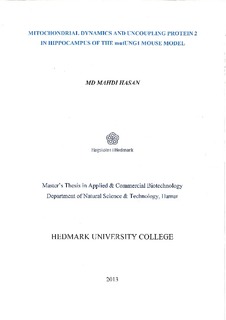| dc.contributor.author | Hasan, Md. Mahdi | |
| dc.date.accessioned | 2013-11-18T11:46:51Z | |
| dc.date.available | 2013-11-18T11:46:51Z | |
| dc.date.issued | 2013 | |
| dc.identifier.uri | http://hdl.handle.net/11250/132363 | |
| dc.description | Mastergradsoppgave i næringsrettet bioteknologi, Avdeling for lærerutdanning og naturvitenskap, Høgskolen i Hedmark, 2013. Master of applied and commercial biotechnology. | no_NO |
| dc.description.abstract | Mitokondrier er viktige organeller for energiomsetningen i nerveceller. Energibehovet er høyere i nevroner enn i de fleste andre celler, og viser seg i form av høyt forbruk av oksygen i hjernen. Endogene reaktive oksygen substanser (ROS) oppstår som et biprodukt av normal oksygenmetabolisme i mitokondriene. I nevrodegenerativ patologi kan ROS føre til oksidativt stress og skader på mitokondrielt DNA (mtDNA). Transgene muter uracil-DNA glykosylase 1 (mutUNG1) mus, som uttrykker mutUNG1-enzymet, induserer mitokondriell toksisitet forårsaket av høye antall apurine/apyrimidine-seter i mtDNA i hippocampus. "Utkoplingsproteinet" (UCP2, uncoupling protein 2) tillater kontrollert protonlekkasje til mitokondriematrix. UCP2 har evne til å beskytte nevroner mot et kritisk høyt mitokondrie-membranpotensial, og gir dermed redusert ROS-produksjon. I denne oppgaven ble en tidligere laget transgen mutUNG1-musemodell brukt til å studere mitokondriemorfologi og tetthet av UCP2 (UCP2 gull partikler/µm²) i ulike deler av nevroner i cornu ammonis 1 (CA1) og i gyrus dentatus. Strukturen på mitokondriene i nevroncellerkroppen, soma, i mutUNG1 mus var forandret sammenlignet med i villtypekontroller. Mitokondrier fra mutUNG1 mus var aggregerte, klumpete, og irregulære i formen, mens villtypemus hadde mitokondrier med normal morfologi i soma. Gjennomsnittlig areal (nm²) av mitokondrier var betydelig økt i både presynaptiske terminaler og i somata hos mus med mutUNG1-uttrykk sammenlignet med villtypemus. Den gjennomsnittlige individuelle mitokondriestørrelsen (nm²) var signifikant høyere i presynaptiske terminaler og i myeliniserte aksoner hos mus med mutUNG1-uttrykk sammenlignet med villtypemus. Elektronmikroskopisk immunogull cytokjemi ble brukt til kvantifisering av UCP2 i ulike deler av nevronet. I mutUNG-uttrykkende mus var tettheten av UCP2 signifikant høyere sammenlignet med villtypemus i myeliniserte aksoner, presynaptiske terminaler, og somata. Denne økningen av UCP2 i myeliniserte aksoner fra mutUNG1-uttrykkende mus kan gjenspeile behovet for å opprettholde aksonal energihomeostase. Den betydelige økningen av UCP2 i presynaptiske terminaler kan bidra til å redde de dysfunksjonelle mitokondriene i mutUNG1-uttrykkende mus. Den økte tettheten av UCP2 i somata kan skyldes det store antallet av skadede mitokondrier, fraktet til somata fra ulike områder av nervecellen i mutUNG1-mus. Denne studien tyder på at UCP2 kan beskytte mot nevrodegenerasjon forårsaket av dysfunksjonelle mitokondrier. | no_NO |
| dc.description.abstract | English abstract. Mitochondria are a crucial site of energy metabolism in neurons. The energy demand is higher in neurons than in most other cells, which is reflected by high consumption of oxygen in the brain. Endogenous reactive oxygen species (ROS), arising from normal oxygen metabolism, are mainly produced in mitochondria. In neurodegenerative pathology, ROS may lead to oxidative stress and mitochondrial DNA (mtDNA) damage. The transgenic mutated uracil-DNA glycosylase 1 (mutUNG1) mice express the mutUNG1 enzyme, which induces mitochondrial toxicity, caused by high numbers of apurinic/apyrimidinic-sites in mtDNA of hippocampal neurons. The uncoupling protein 2 (UCP2) has the property to allow controlled proton leakage into the mitochondrial matrix. UCP2 has the ability to protect neurons against a critically high mitochondrial membrane potential, therby reducing ROS production. In this thesis, a previously made mutUNG1-expressing mouse model was used to study mitochondrial morphology and to quantitate the density of UCP2 (UCP2 gold particles/µm²) in different compartments of neurons in the cornu ammonis 1 (CA1) and dentate gyrus. The structure of the mitochondria in somas was markedly different in mutUNG1-expressing mice compared to wild type littermates. The mitochondria in mutUNG1 expressing mice were aggregated, clustered, and irregularly shaped while the wild type mice had a regular mitochondrial shape in the somas. The average area (nm²) of mitochondria was increased significantly in presynaptic terminals and somas of mutUNG1-expressing mice compared to wild type mice. The average size (nm²) of individual mitochondria was significantly higher in presynaptic terminals and myelinated axons of of mutUNG1-expressing mice compared to wild tpe mice. Electron microscopic immunogold cytochemistry was used used to quantify mitochondrial UCP2 in different neuronal compartements. In mutUNG1-expressing mice, the density of UCP2 was significantly higher compared to wild type mice in myelinated axons, presynaptic terminals, and somas. The significantly higher mitochondrial UCP2 in myelinated axons and in presynaptic terminals could help to rescue dysfunctional mitochondria in mutUNG1-expressing mice. The significantly increased density of UCP2 in the somas could result from the large numbers of damaged mitochondria, transported to the somas from different compartments of the neurons in the mutUNG1-expressing mice. The present study suggests that UCP2 is neuroprotective against neurodegeneration caused by mitochondrial dysfunction. | |
| dc.language.iso | eng | no_NO |
| dc.subject | uncoupling protein 2 | no_NO |
| dc.subject | mitochondrial dynamics | no_NO |
| dc.subject | hippocampus | no_NO |
| dc.subject | mutUNG1 | no_NO |
| dc.subject | neuronal compartments | no_NO |
| dc.subject | Applied and commercial biotechnology | no_NO |
| dc.subject | Næringsrettet bioteknologi | no_NO |
| dc.title | Mitochondrial dynamics and uncoupling protein 2 in hippocampus of the mutUNG1 mouse model | no_NO |
| dc.type | Master thesis | no_NO |
| dc.subject.nsi | VDP::Technology: 500::Biotechnology: 590 | no_NO |
| dc.source.pagenumber | 104 | no_NO |
